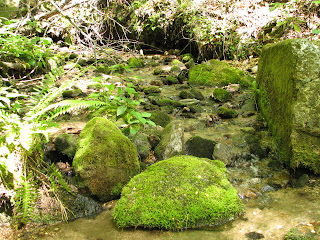 Another thing I spent quite a bit of time on at Bat Fork Bog was developing an understanding of how water worked in the Preserve. This turned out to be a fascinating experience that involved the bog in times of drought and in times of flood Only two places on the Preserve retained water throughout the year. We dug test ‘wells’ throughout the Preserve to find water during drought but, with the exception of the two locations noted, it was not there or it was down so far as to be useless in increasing habitat for the bunched arrowhead. In fact, water was mostly a feast or famine thing at the Preserve. When it was feast it was, literally, a movable feast because during those time of exceptionally heavy rainfall, water would flow into the bog from the surrounding uplands and adjacent Bat Fork Creek would overflow discharging hundreds of thousands of gallons into the shallow bowl of the Preserve and putting otherwise fairly dry land a meter or two underwater. We published a preliminary hydrological study of the Preserve in Natural Areas Journal.
Another thing I spent quite a bit of time on at Bat Fork Bog was developing an understanding of how water worked in the Preserve. This turned out to be a fascinating experience that involved the bog in times of drought and in times of flood Only two places on the Preserve retained water throughout the year. We dug test ‘wells’ throughout the Preserve to find water during drought but, with the exception of the two locations noted, it was not there or it was down so far as to be useless in increasing habitat for the bunched arrowhead. In fact, water was mostly a feast or famine thing at the Preserve. When it was feast it was, literally, a movable feast because during those time of exceptionally heavy rainfall, water would flow into the bog from the surrounding uplands and adjacent Bat Fork Creek would overflow discharging hundreds of thousands of gallons into the shallow bowl of the Preserve and putting otherwise fairly dry land a meter or two underwater. We published a preliminary hydrological study of the Preserve in Natural Areas Journal.  Poison ivy was ubiquitous at the Preserve and I felt like I had that itching irritation going on some part of my body at least half of the time I sloshed around in those wetlands. On the other hand, the Preserve had delightful surprises. One of the most enjoyable of these surprises was the family of coyotes that lived in an embankment along one of Preserve boundaries. These curious, melodic creatures would howl almost every time the siren at the nearby fire station cut loose. They, especially the young ones, would also follow my travels around the Preserve, sometimes just moments behind me and I would see them poking their curious noses out of the thick grasses watching me.
Poison ivy was ubiquitous at the Preserve and I felt like I had that itching irritation going on some part of my body at least half of the time I sloshed around in those wetlands. On the other hand, the Preserve had delightful surprises. One of the most enjoyable of these surprises was the family of coyotes that lived in an embankment along one of Preserve boundaries. These curious, melodic creatures would howl almost every time the siren at the nearby fire station cut loose. They, especially the young ones, would also follow my travels around the Preserve, sometimes just moments behind me and I would see them poking their curious noses out of the thick grasses watching me.
Bat Fork Bog Preserve and other places like it may be small but they can offer exceptional opportunities for the study of specific aspects of the natural history of the vanishing wet places of our world.
Publications
Baugh, T. and R.E. Evans. 2011. Restoration of a Southern Appalachian Mountain Bog Phase II-Hydrology. Natural Areas Journal 31(1)501-504.
Baugh, T., R.E. Evans, C.J Stewart, and S. Artebane. 2011. Restoration of a Southern Appalachian Mountain Bog: Phase I. Reed canary grass removal. Ecological Restoration 9(1):13-14.
Baugh, T. and K. Schlosser. [In press]. Management considerations for the restoration of bunched arrowhead Sagittaria fasciulata. Natural Areas Journal [January 2013].
Baugh, T. and K. Schlosser. [In press]. Management considerations for the restoration of bunched arrowhead Sagittaria fasciulata. Natural Areas Journal [January 2013].
































